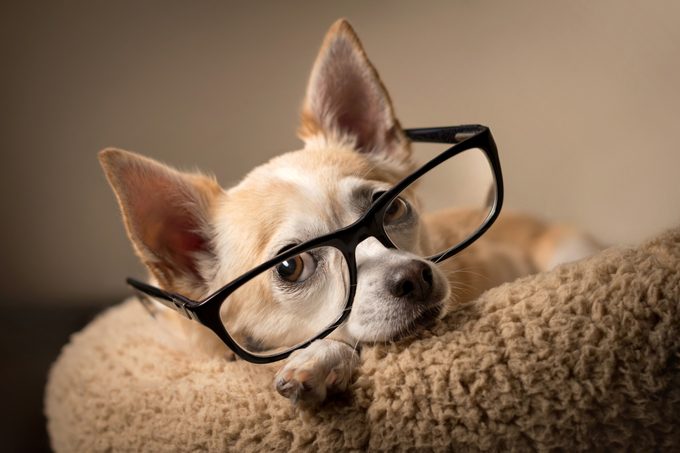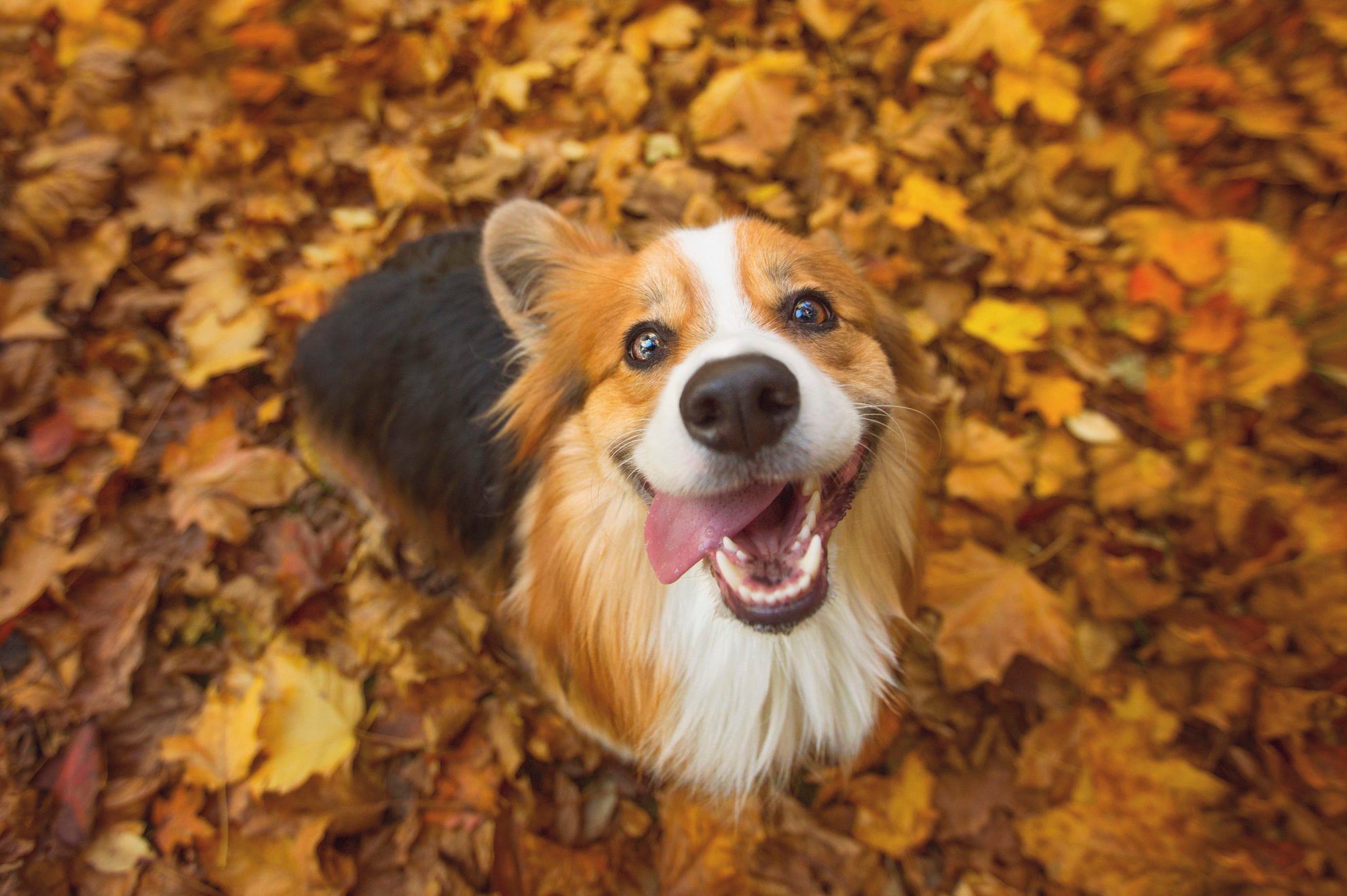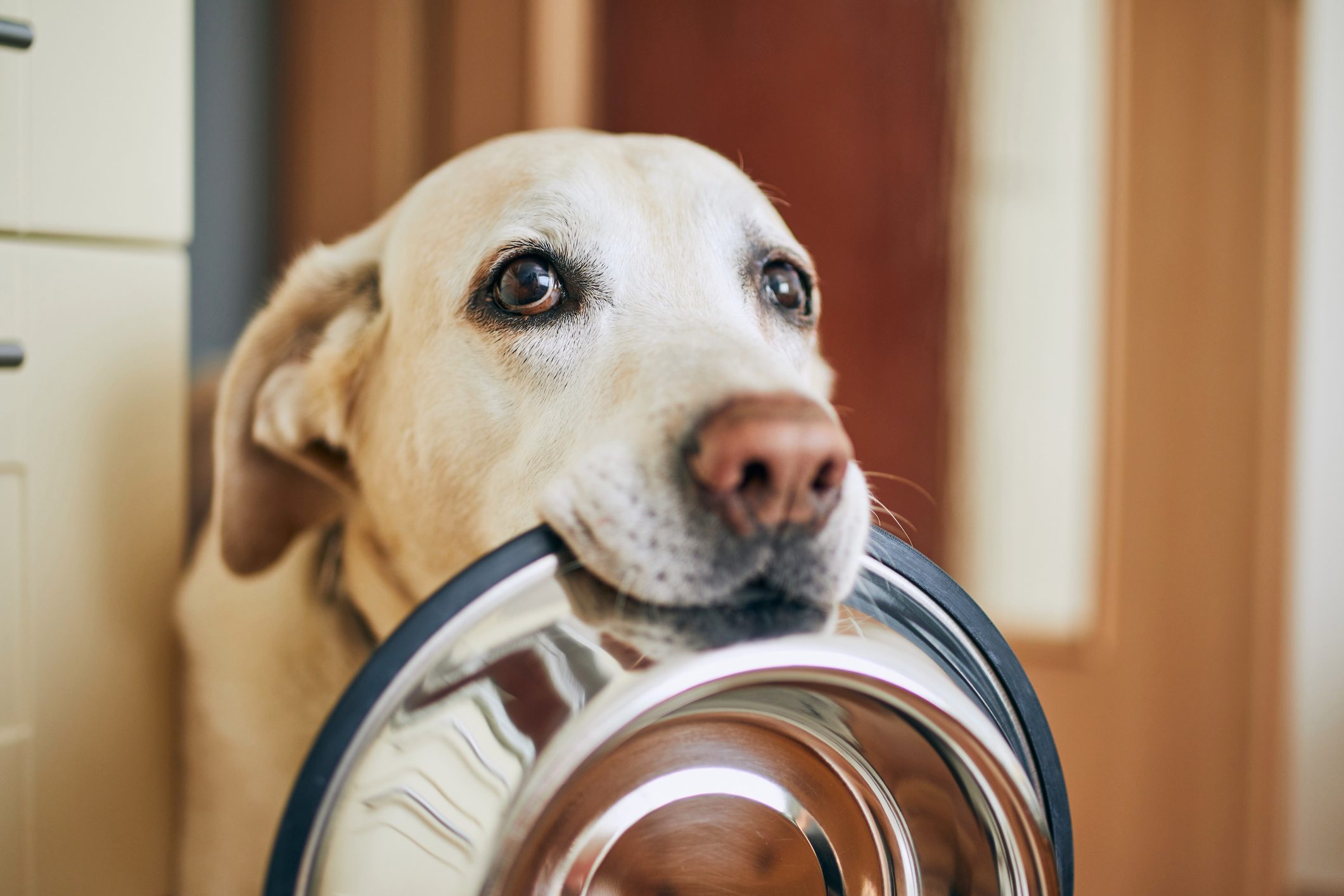They may not speak our language, but dogs are always communicating. Here’s what we know—and wonder—about what dogs think about.

What Do Dogs Think About?

Have you ever looked at your dog and wondered what’s going on behind those soulful eyes? Whether they’re wagging their tail, tilting their head or just staring into space, pups everywhere are prompting owners to ask life’s most important question: What do dogs think about? (OK, it’s the most important question to us.)
“Dogs are smarter than most people give them credit for, and there’s no denying that they have a mind of their own and can experience a range of emotions, including guilt, joy, frustration and grief,” says Linda Simon, DVM, a licensed veterinarian and veterinary consultant for ThePets. Think about the “sad eyes” they send your way when scolded or the look of betrayal they give when the cat gets a treat instead of them. Some dogs have even been known to wait loyally for a deceased owner to return—proof that they’re thinking about something.
Understanding how dogs think means resisting the urge to assume they see the world the same way as us. As Dr. Simon explains, anthropomorphizing—attributing human thoughts and emotions to dogs—can distort how we interpret their behavior. Instead, learning what actually motivates your pup will strengthen your connection and help you better meet their needs.
Ahead, we break down what science, real-life observations and research into dog cognition tell us about the thoughts that might be running through your dog’s mind each day and what your dog actually wants from you.
Get Reader’s Digest’s Read Up newsletter for more pet insights, humor, tech and fun facts all week long.
What do dogs think about all day?
From food and affection to routines, relationships and their surroundings, dogs spend their days tuned into the world around them and the humans they love. Experts say that understanding what dogs think about can help you recognize their emotional needs, decode their behavior and build a stronger bond.
While we may never know every thought in their heads, one thing is certain: You’re probably at the center of it. Read on for 13 things your pooch may be thinking throughout the day.
“Hey, I love you!”
Dogs don’t hold back when it comes to showing affection. “There’s a reason we refer to them as man’s best friend,” Dr. Simon says. “When your dog jumps up on you as you walk through the door, wags their tail when they spot you from afar and covers you in slobbery kisses, you can be confident they’re thinking Hey, this person is pretty swell!”
Dogs aren’t subtle about love. Their body language says it all, and once you learn to read those signs, you’ll start to recognize the ways your pet is trying to say “I love you.”
“You hurt my feelings!”
“Some dogs are particularly sensitive to criticism and may exhibit signs of anxiety when being reprimanded, such as hiding away or even trembling,” Dr. Simon says. “Other dogs will act quite unfazed by a good scolding or even cocky, and as soon as you’re done, it’s clear they’re not thinking about it at all anymore.”
If your pup tends to shut down or hide when corrected, it may be a sign they’re especially sensitive. In that case, a gentle, positive training approach can help ease their anxiety and build trust over time.
“Fido was here too!”
Dogs love to check their “pee-mail” by sniffing around the neighborhood or on walks. This behavior isn’t just territorial—it’s their way of gathering information about which dogs (and other animals) have passed through, says Heather Venkat, DVM, MPH, DACVPM, a veterinarian for the Arizona State Public Health Department. “As they sniff, they take in a lot of information about a lot of other dogs, not to mention other animals and humans,” she says.
Scent plays a major role in what dogs think about, especially during walks. Not giving them the time to explore these smells is actually one of the things you do that your dog hates, so let them linger and take it all in.

“Does that bunny want to play tag?”
Dogs are naturally inquisitive, and many can’t resist the sight of squirrels, birds or rabbits, Dr. Venkat says. “Your dog is wondering where those animals are and if they can play with them or interact with them,” she says.
While this curiosity might seem playful, it can quickly shift into rough behavior or even hunting instincts. To keep wildlife (and your dog) safe, it’s best to keep them leashed and let them observe from a distance.
“Never fear, I will guard the little humans!”
Protecting the pack is instinctual for dogs, and many are especially attentive when it comes to young children. “Dogs who spend a lot of time around children and play with them from a young age can develop beautiful relationships,” Dr. Simon says. “Things can work out especially well if the dog is young when the baby arrives, meaning they can mature together and become each other’s playmate.”
If your dog grew up alongside your kids, chances are, they’ve formed a deep bond, and your pup might even see themselves as the children’s guardian.
“Dog? What’s a dog?”
Some dogs, especially those that didn’t grow up around other dogs, form much stronger bonds with their humans than with their fellow canines, Dr. Simon says. “These dogs likely don’t give a whole lot of thought to dogs in general. Their humans are their ‘pack,’” she says. “You can tell if your dog thinks this way if they ignore other dogs when out on a walk.”
If your pup seems uninterested in other dogs and stays laser-focused on you, it’s probably because they see you as their one and only family.
“What is this new thing, and why does it keep making that noise?”
A new baby brings big changes, not just for the humans in the house but for your dog too. “When a new baby comes home, you’ll see them trying to figure out how they are supposed to play with it, the proper way to behave around it, and likely wondering why it keeps crying,” Dr. Venkat says.
While your pup may be curious and a little confused at first, most dogs adapt quickly, especially if they’re gently included in the new routine and given time to adjust.
“The Fed-Ex man will kill us all—but not on my watch!”
“Dogs are always thinking about how to protect their family from any outside threats,” Dr. Venkat says. Of course, their idea of a threat may not match yours—cue the constant barking at neighbors, squirrels or the unsuspecting mail carrier.
Whether they’re bravely leaping to your defense or just letting the world know they’re on patrol, your pup takes their job seriously.
“It’s dinnertime! Bring on the food!”
“We know that dogs like a routine. It makes them feel secure and cared for. So if you have a routine, it’s probably quite easy to know what your dog is thinking about,” says Julie James, a dog behavior expert and certified dog trick instructor for The Animal Talent.
Dogs are surprisingly good at telling us what part of the day they’re focused on, whether that’s mealtime, walk time or bedtime. But when we miss the cues? Let’s just say our pups are great at letting us know when we’re guilty of that rude pet habit.
“Has it been 10 minutes or 10 days since my human left?”
Most dogs don’t mind when you leave the house for short stretches. But for pups with separation anxiety, it’s a different story, Dr. Simon says. “Some dogs find it hard to cope when they are left alone in the house, and you can tell they are thinking anxious thoughts by exhibiting behaviors that may include barking, panting and even furniture chewing,” she says. “We can assume that these dogs are unhappy, bored or lonely. They may even be fearful that we are not coming back.”
These strong reactions are a powerful example of canine emotions. If your dog struggles with your absence, it’s worth talking to a vet or trainer about ways to reduce their anxiety and help them feel more secure.
“I love eating things that smell like your feet!”
A dog’s nose leads the way—especially when it comes to their favorite person. According to James, smell is their primary sense, and they’re drawn to items that carry your strongest scent, like socks, shoes or even underwear. These often become their favorite chew targets. “Will he feel guilty about keeping himself busy chewing your things? Nope,” she says.
It’s not mischief; it’s a kind of love. Give your dog plenty of chew toys to redirect their affection to something less laundry-based.
“This is the way to the dog park!”
With time and routine, many dogs develop a surprisingly good sense of direction, James says. “I know my dog understands we are going to the dog park because he’s always so enthusiastic on the way there,” she says. “I walk him to different parks for variety, and sometimes I let him decide which route to take and which park to go to. You can try it with your dog: Let them choose the route, and see where they lead you. Maybe they’ll surprise you by leading you to the pub instead!”
Whether it’s the park or the pub, your pup’s enthusiasm for the journey is just one more way they show you how much they love spending time with you.
“You have treats in your pocket!”
Generally speaking, food tops the list of what dogs think about each day. “I think that for most dogs, food is the No. 1 thing they think about,” James says. “Every day, my dog sits and stares at me for at least an hour before it’s time for his supper, so I can’t forget to feed him. I know that he loves training because he gets to eat lots of treats, and I know he loves bedtime solely because he gets a bedtime treat!”
From breakfast to bedtime, food shapes much of your dog’s behavior. Practicing the everyday habits of great dog owners, like using treats during training, is one small way to strengthen your bond.
FAQs
Do dogs understand the passage of time?
Yes, dogs can track time through patterns and routines, even if they don’t measure it like humans. Their behavior often reflects an awareness of daily rhythms and expected events.
Can dogs feel complex emotions?
Yes, dogs can experience a range of emotions, including joy, sadness, fear and affection. While their emotions may not be as layered as human feelings, they are still genuine and influential in how dogs behave.
How do dogs respond to human behavior?
Dogs are highly responsive to human tone, facial expressions and body language. They learn to associate certain behaviors with outcomes and often adjust their actions based on how we behave.
About the experts
|
Why trust us
At Reader’s Digest, we’re committed to producing high-quality content by writers with expertise and experience in their field in consultation with relevant, qualified experts. We rely on reputable primary sources, including government and professional organizations and academic institutions as well as our writers’ personal experiences where appropriate. We verify all facts and data, back them with credible sourcing and revisit them over time to ensure they remain accurate and up to date. Read more about our team, our contributors and our editorial policies.
Sources:
- Linda Simon, DVM, small animal surgeon and veterinary consultant for ThePets
- Heather Venkat, DVM, MPH, DACVPM, state public health veterinarian for Arizona
- Julie James, certified dog behavior expert and trick dog instructor
























